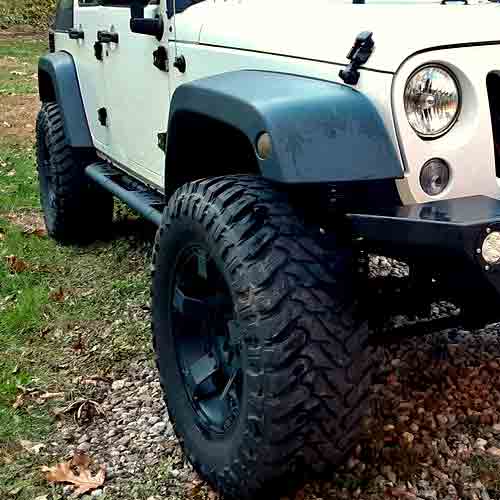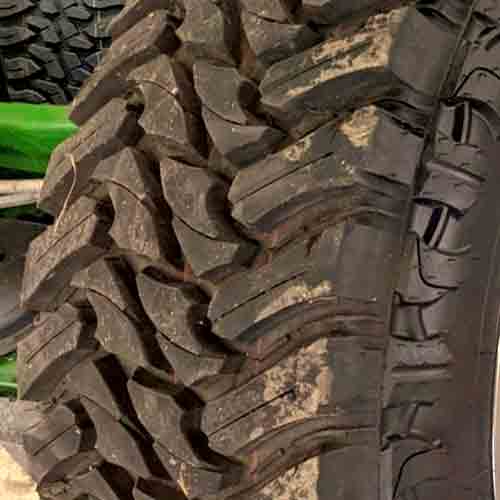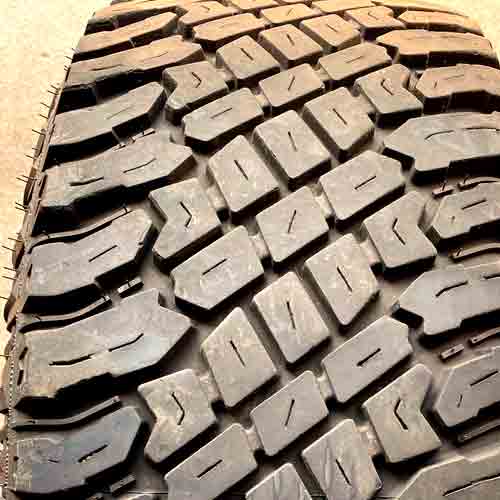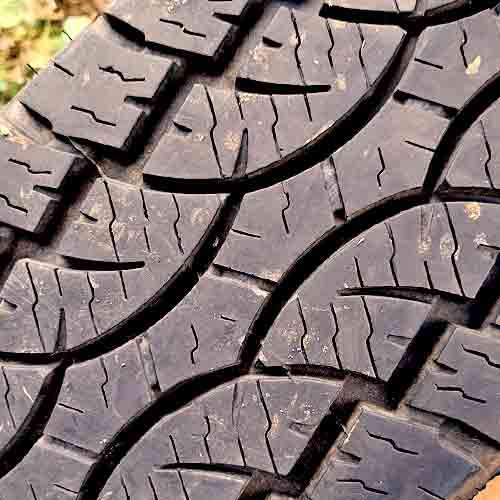Whether you’re on the highway or off the beaten path, the Atturo Trail Blade line up has got you covered. If you are looking for some serious off-roading, you can never go wrong with its mud-terrain variant, whereas if you need on-road comfort with a little bit off-road traction, go with A/T, the XT is the one offering better on-road grip, compared to M/T, and at the same time, better off-roading capabilities compared to A/T. Let’s check these tires out in more details.

Table of Contents
Available Sizes
The Atturo Trail Blade AT comes in 26 sizes in 15 to 20 inches having following specs.
- Speed rating: S and T.
- Load rating: SL, XL and C only.
- Weight range: 35 to 45 lbs.
- Tread depth range: 13 to 15/32″.
- Winter ratings: branded with 3PMSF.
- Warranty: 50k miles on all sizes.
- UTQG: 540 A B.
The Atturo Trail Blade XT comes in 30 total sizes in 17 to 24 inches with following specs.
- Speed rating: Q, S and H.
- Load rating: XL, C, D and E.
- Weight range: 30 to 84 lbs.
- Tread depth range: 13.5 to 18/32″
- Not rated with 3PMSF.
- 45,000 mile tread life warranty
- UTQG: 460 A B.
And the Atturo Trail Blade MT, on the other side, comes in a total of 17 limited sizes in 16 to 22 inches, having following specs:
- Speed ratings: R and Q.
- Load ratings: XL, D and E.
- Weight range: 40 to 80 lbs.
- Tread depth range: 17 to 20/32 inches.
- UTQG: 350 A B.
Tread Pattern
Starting form the Atturo Trail Blade MT, let me divide this section in to two parts, shoulders and middle area.

In the middle:
- 2 similar ribs are featured, each consisting of similar sharp edged lugs with chamfered sides and full depth sipes.
- Despite having a softer compound and a lot of tread depth, these lugs are kept stable during handling/braking as they have reinforced foundations underneath them all.
On shoulders:
- These lugs are elongated, and they take up most of the tread’s space.
- Moreover, the grooves they make are also wider then any seen on the tread, featuring bold stone ejectors in between.
- The outer edges of these shoulders are staggered, and you also get dual sidewall design on each side of the tire with a lot of sharp biters.
Moving towards the Atturo Trail Blade XT, the tire features a less aggressive design of course.

In the middle:
- The squared off lugs are placed in a lateral fashion.
- They join the two shoulder lugs in a wave-like fashion, forming asymmetric tread.
- They are equipped with full dept rectilinear sipes.
- And to enhance stability lugs are also joined up together.
On shoulders:
- Lugs are elongated and more spaced up.
- They have stone ejectors in between.
- They also carry full depth rectilinear sipes.
- They outer margins are not staggered, but still biting.
- And this goes especially for sidewall lugs, where there are numerous biters.
Moving towards its AT variant.

In the middle:
- The tire features continuous running rib equipped with interlocking sipes, though they can get better.
- The surrounding ribs have thicker lugs, with notches along with sharp edges, and slightly longer full depth siping.
- These ribs are separated form the shoulder lugs with largest of all tread voids.
- Though the forms 4 in total of these circumferential channels.
On shoulders:
- Lugs are very blocky.
- They sit on a continuous running secondary rubber layer underneath.
- They are missing with stone ejectors.
- These lugs are also equipped with similar siping and notches as seen in the middle.
- They also lack staggered design, so there aren’t any mud scoops.
Durability And Toughness
Off-roading involves challenging terrains and severe conditions, thus off-road tires need to be robust, with powerful plies in their internal structure, particularly sidewalls (as that’s the most vulnerable area on the tire).
And so here, the most durable out of the three, is Atturo M/T, featuring 3 ply polyester casing, reinforced by two steel belts and cap plies.
The Trail Blade X/T comes in 2nd here, which also features 3 ply sides, though doesn’t provide with thick enough sidewall lugs, like the M/T which adds further toughness.
And the Trail Blade AT comes in least durable with just 2 ply sidewalls.
Grip
In the world of tires, with a more voided up designs tend to struggle with maintaining traction due to reduced rubber to surface contact, and so its not a surprise, why out all, the Atturo Trail Blade MT, with its pronounced voids, gets to face a lot more challenges in this specific area.
In comparison, the Atturo Trail Blade AT, designed for versatile all-terrain usage, offers better road engagement.
Its design includes a continuous central rib that makes a consistent contact with the road, and its reinforced foundations allow for much better braking efficacy, and stability.
The Atturo Trail Blade XT, comes in the middle of the two, as its braking distances literally shows. Though its fascinating to note that, the tire only lacks to it’s less aggressive brother by only less than a feet.
Handling
A tire’s handling is determined by the flexibility of the tread and the design of the shoulder lug. And considering these factors, it’s not surprising that the Atturo Trail Blade AT comes out with highest of all lateral g forces (a measure of overall curving efficacy of the tire).
But why the shoulders? Well because as the tire turns, the weight on it, gets transferred towards the extremities, because of the inertia. So how well the tire connects form there is significant.
And with Trail Blade A/T having such closed up shoulder lugs, having reinforced foundations, allow for quick steering response and turning capability.
Conversely, the Atturo Trail Blade MT, with its softer compound and less block support, shows a higher tendency for oversteering and understeering. And of course, the large spacing between its lugs reduces the tread to ground contact, thereby limiting handling efficiency.
Same is the case with Trial Blade X/T, although its lugs don’t bend as much, as the tire features slightly lighter weight and it doesn’t feature as softer of the tread, there are still a lot of lateral gaps between the shoulder blocks.
So the overall handling is still limited, (though still better than M/T).
Rugged-Terrain Traction
Off-road, its expected that Atturo Trail Blade MT would be much better, but how well those other less aggressive tire do here? Well lets find out by considering all the terrain types.
Desert Performance
In sandy environments, tires must be designed to stay afloat and prevent sinking, (as digging in to the sand leads to very problematic situations, saying form experience).
While one might assume that heavier tires would be more prone to sinking, it’s actually about the density of the tire. That’s why the Atturo Trail Blade MT, though heavier, still manages to stay afloat in a better way, mostly due to its sidewall lugs, which expand out, with lowered air pressure.
The Trail Blade XT and AT really under-perform in this context.
In case of AT, you don’t get sidewall lugs, so lowering air doesn’t do much for it.
And as for Atturo Trail Blade X/T, you do get sidewall lugs, but they are very sharp, so the overall floating efficacy gets ruined. Though still, it performs better compared to A/T, I can give you that.
Climbing Rocks
Rock climbing presents a significant challenge, as it requires tires to be able to grip in all directions, and yes you also need a lot of tire durability (as most of the punctures happen on this terrain type).
And so out of all boys, the Atturo Trail Blade MT stands out in terms of toughness with its 3-ply sidewalls and a thicker rubber surface.
And as for the grip, the tire features thick lugs, which grab on to the rocky surface with bigger groove mouth.
Moreover, the tires thick sidewall lugs further increase biting efficacy with reduced air pressure, that is.
The Atturo Trail Blade X/T is also a pretty great tire here, on the other hand, it also comes out with 3 ply sidewalls, and feature great biting through its shoulders and sharp sidewalls. Though its central lugs don’t generate ample directional grip, as lugs are pretty closed up (and literally joined up with each other, with connectors).
Though of course, the most lacking tire here would have to be the Trail Blade A/T, which is the most deficient in providing both lateral and longitudinal traction.
Muddy Trails
In muddy conditions, a combination of digging and evacuating abilities is required in a tire.
And so with such closed up tread voids, the Trail Blade A/T severely lacks here. Its tread consist of longitudinally aligned ribs, which are continuous running, so they don’t permit mud to travel (out of the tread), from sideways.
The Trail Blade XT although features better design, with pretty voided up shoulder lugs, it’s central central is pretty crowded, so its also susceptible to mud packing.
That’s why here the Atturo Trial Blade MT is the only one which does the job best, with its highly voided structure, which allows mud to exit freely, while its thick mud scoops combined with sidewall lugs provide impressive paddling capabilities.
Snow Performance
Both the Atturo Trail Blade AT and XT are pretty great when it comes to snow traction, so this explains why they both have severe winter ratings of 3PMSF. (Learn all about this rating here).
Though still out of these tires, the Trail Blade XT still manages to come out better with it’s laterally oriented lugs, allowing for efficient mud scooping abilities, and at the same times forming snow to snow contact.
This type of contact is crucial as snow adheres more effectively to itself than to the tread.
The Atturo Trail Blade MT, on the other hand, excels in deeper terrains. Its thicker lugs effectively paddle, scooping the snow out of their way, thus creating forward momentum.
Tread and Fuel Economy
Fuel consumption can be largely impacted by the weight of its tires as well as the the grip of the tread. In this context, the Atturo Trail Blade AT demonstrates excellent fuel efficiency due to its relatively lighter construction, firm lugs, and reduced spacing, though while still providing with decent gripping values.
A lighter tire is advantageous as it requires less energy to move, and coupled this, with firm lugs and tighter tread gaps, the lugs/tread blocks bending is minimized. Therefore, less energy is expended in “bending”, and more is dedicated to the overall rolling the tire.
However, the Atturo Trail Blade MT and XT fall short in this aspect, primarily due to their heavier structure. These tires exhibit increased rolling inertia due to their weight, and their lugs are more prone to flexing, leading to greater fuel consumption.
Moreover, the greater weight also causes the lugs to press harder against the road, and this combined with their softer tread compounds, you get lower efficacy in the treadwear department as well.
Though still, as the Trail Blade XT still has closed up tread voids, it only lacks slightly compared to AT.
But still, it’s understandable why the Atturo Trail Blade MT lags behind here the most, coming with lowest of all UTQG, while the Trail Blade XT and AT give out 460 and 540 A B respectively, with only 5k miles in warranty treadwear difference.
Take Home Points
Taking into account all the discussed aspects, including on-road performance, winter conditions, fuel economy and so on, we can summarize the overall assessment of these 3 tires.
The Atturo Trail Blade MT impresses with its performance on rough terrains, rock climbing, and in deeper snow, thanks to its robust structure, superior durability, and effective paddling abilities. However, it falls short in terms of fuel efficiency and tread life, given its heavier weight and aggressive tread design.
The Atturo Trail Blade AT excels in fuel efficiency and offers commendable tread life, making it a good choice for on-road driving and light (very light I mean) off-roading. Though still, the tire could really use some sidewalls.
Finally, the Atturo Trail Blade XT strikes a balance between the MT and AT. It performs reasonably well in most conditions, offering better floating capabilities on sandy terrains and satisfactory performance on snowy paths. However, it lacks the aggressive tread design of the MT (especially form the middle), and so it can’t offer decent performance when it comes to harsh off-road terrains.
In conclusion, each tire has its strengths and weaknesses, and the choice between them should be dictated by the specific requirements and expected driving conditions.